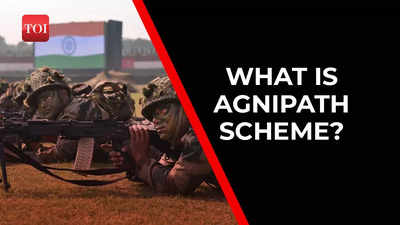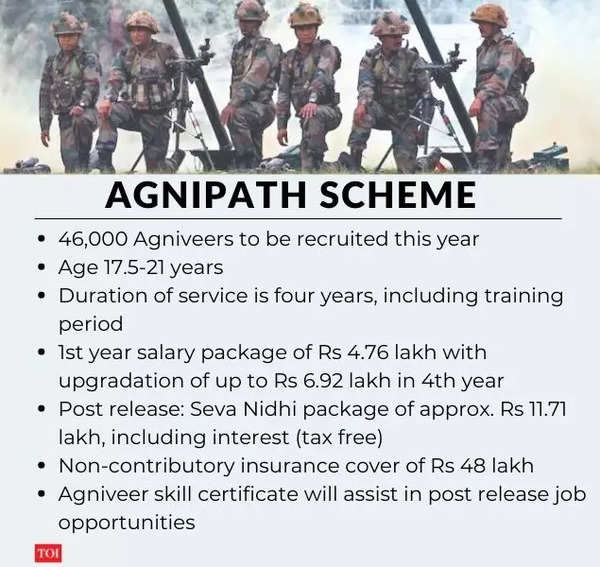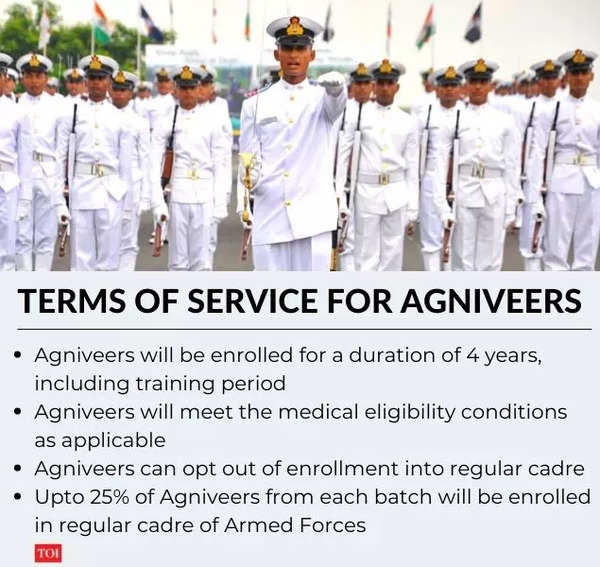
India's military is overhauling its recruitment process for personnel below officer rank, aiming to deploy fitter, younger troops on its front lines, many of them on short contracts of at most four years.

NEW DELHI: India's military is overhauling its recruitment process for personnel below officer rank, aiming to deploy fitter, younger troops on its front lines, many of them on short contracts of at most four years.
Unveiling the 'Agnipath' scheme on Tuesday, defence minister Rajnath Singh said the "transformative initiative would provide a youthful profile to the Army , the Navy and the Air Force".


Under the new system, men and women between the ages of 17.5 and 21 will be brought into the armed forces.

However the government late on Thursday night announced the upper age limit for candidates will be increased to 23 from 21 for 2022, as a one-time waiver. The relaxations has been allowed due to Covid disruptions over the past two years.
A total of 46,000 soldiers will be recruited this year on four-year contracts. "Under the Agnipath scheme, Indian youngsters will be provided an opportunity to serve in the armed forces as 'Agniveers'," the defence minister said.

After four years, 25% of the Agniveers will be retained or re-enlisted in the regular cadre based on merit, willingness and medical fitness. They will then serve for a full term of another 15 years. The other 75% Agniveers will be demobilised, with an exit or “Seva Nidhi” package of Rs 11-12 lakh, partly funded by their monthly contributions, as well as skill certificates and bank loans for help in their second careers.

Youthful profile for Armed Forces
The "Agnipath" scheme, earlier christened as "Tour of Duty", was launched in the presence of the chiefs of the three services. The defence ministry said the scheme comes into immediate effect and will govern the enrolment for the three services, implying that existing framework of employment for soldiers will cease to exist.
Navy chief Admiral R Hari Kumar said the scheme will ensure a wider talent pool for recruitment in the armed forces, adding that women will also be inducted into armed forces under it.

Army chief General Manoj Pande said the scheme aims to bring a paradigm shift in recruitment in the armed forces. It will help ensure optimum balance between youth and experience in the Army, he added. General Pande said the Army's operational capability will be fully maintained during the initial implementation stage of the scheme. Currently, the Army recruits young people under the short service commission for an initial tenure of 10 years, which is extendable up to 14 years.
Air Chief Marshal V R Chaudhari said the IAF is looking to tap into the source of dynamic young people and it will train and expose them to the high tech environment and hone their skills for future employment.
"The new scheme therefore gives the IAF an opportunity to draw from the vast pool of talent available in the country," he said.
' Average age in Army to drop from 32 to 26'
Military officials said the new system would help bring down the average age of the armed forces. In the Army, the average age would drop from 32 to 26, General Pande said.
"A more youthful profile will help train troops more easily in newer technologies, and their health and fitness levels will be much better," Singh said, adding that employers would benefit from skilled workers once they left the armed forces.
Lieutenant General Anil Puri said that Agniveer would be part of the 'future-ready' soldier. "Agniveer would be India's young protector. After being with us for 4 years, an Agniveer's resume and biodata will be very unique. He will stand out in the crowd with his attitude and skills," he said.
Restructuring defence budget
The new scheme, which has been announced after extensive deliberations over the last two years, is also aimed at cutting ballooning salaries and pension bill.
The defence budget of Rs 5,25,166 crore for 2022-23 included Rs 1,19,696 crore for defence pensions. The allocation for revenue expenditure was Rs 2,33,000 crore. The revenue expenditure includes the expenses on payment of salaries and maintenance of establishments.
India has the second largest active armed forces in the world with some 1.45 million active duty personnel.
Along with reserves and paramilitary forces, India has over 5 million military personnel -- above China and Russia -- and is the 4th largest military in terms of total personnel.
However, it ranks 9th in terms of total military personnel per 1,000 capita; and 10th in active duty personnel per 1,000 capita.
It also has the third largest military budget in the world after US ($801 billion) and China ($292 billion). However, India spends a large portion of this budget on paying pensions, salaries and maintenance.
According to a report by Global Firepower (GFP), which tracks military capability and defence networks, India has the fourth most powerful military in the world.
The GFP ranking is based on each nation's potential war-making capability across land, sea, and air fought by conventional means.
(With inputs from agencies)